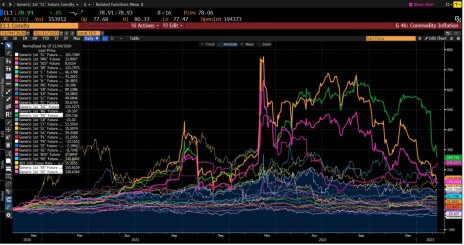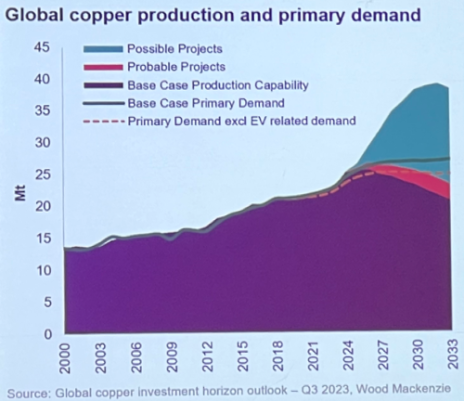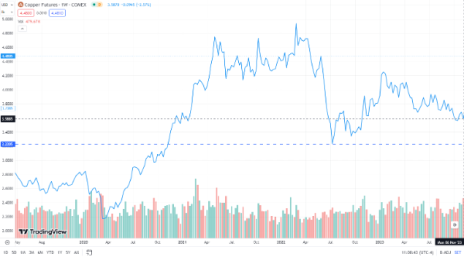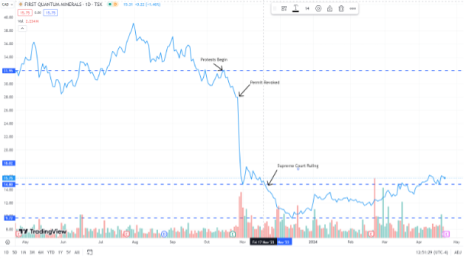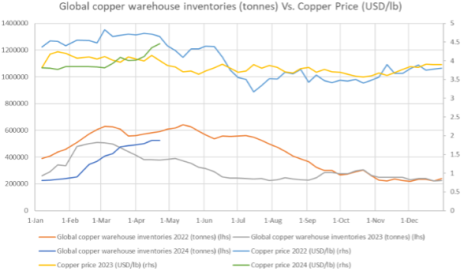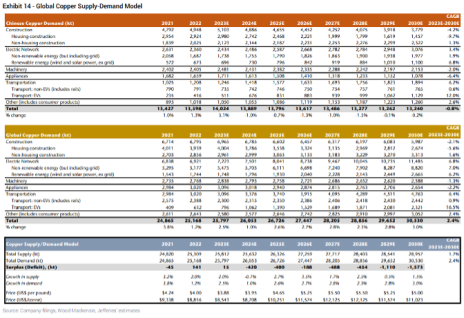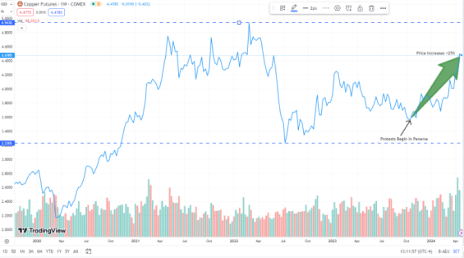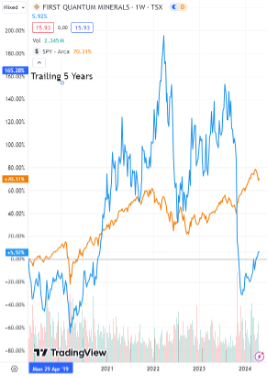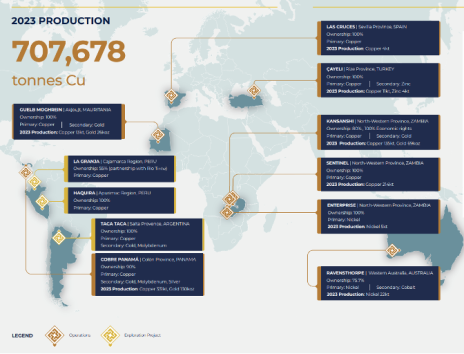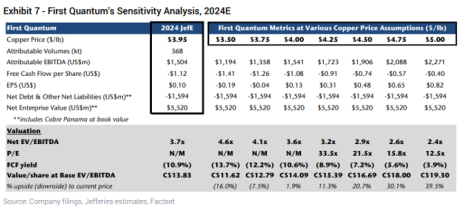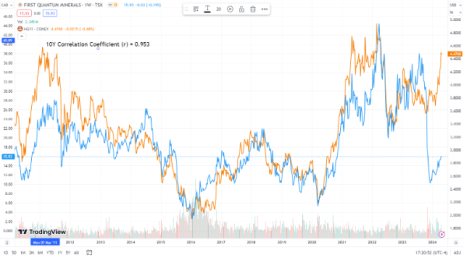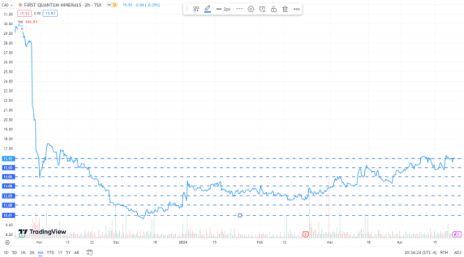Capitalize on Copper Inflation via This Cyclical with Catalysts
In twenty years of price forecasting, the most valuable lesson I have learned is that rate of change tells us everything we need to know about the immediate future. When it accelerates, it tends to continue accelerating. When it decelerates, it tends to continue decelerating. And surprisingly, this tends to be the case no matter what metric we choose to examine.
This constant push and pull of supply, demand, price, cost – and sometimes personnel – creates a continuous feedback loop we all know as the business cycle. More importantly, a deep understanding of those ebbs and flows provides us with a process by which we can identify inflection points in that cycle. If external catalysts accompany those inflection points, they fuel one of the most powerful turnaround mechanisms in existence. And we need look no further than the aftermath of the COVID lockdowns in 2020 to find such examples, as the cost of restarting global trade proved to be visibly enormous, per the commodity inflation chart below.
Logistical bottlenecks caused by a sluggish supply chain drove most commodity prices to increase by 100% or more as demand returned to normal levels. Energy and industrial material prices proved especially volatile, with thermal and metallurgical coal indices rising over 600% and outperforming all other asset classes – including cryptocurrencies at the peak of their mania. And believe it or not, the market is still feeling the aftershocks.
Though global trade has shaken off the rust from COVID, tensions caused by geopolitical, macroeconomic, and socioeconomic conflicts remain amplified. Military actions in Ukraine and the Middle East continue to dominate media headlines. Uncapped fiscal spending programs such as the CHIPS Act and the Inflation Reduction Act are funneling billions of dollars into project development – and therefore commodity markets – as the United States seeks to reshore manufacturing. Protests around the world are intensifying due to conflicting government policies on climate change, environmentalism, territorial disputes, and energy/materials security. And there is no better way to illustrate the interplay of all these disparate factors than to look at recent events in the copper market.
Background: Setting the Stage
Heading into the fall of 2023, most investment banks and institutional research houses – including my former colleagues at Wood Mackenzie – were calling for copper supply to return to a small surplus this year. At the time, this was a completely reasonable assumption. Protests at Chile’s Codelco operations that had occurred earlier in the year had died down, production was beginning to ramp back up, and demand was finally inflecting lower following a massive global policy push toward copper-intensive electric vehicles.
As a result, copper prices had finally stabilized in the mid-$3/lb. range, and per the chart below, seemed poised to retest the prior season’s lows upon completion of the restocking cycle.
But little did my fellow commodity market analysts and I know as we were sitting through presentations at LME Week in London, a storm was quietly brewing across the Atlantic. The Panamanian government was in the process of reviewing the permit renewal for the Cobre copper mine operated by First Quantum Minerals (FM.TO), at the time the world’s sixth-largest producer. Despite initial pushback over terms of the royalty agreement, the permit was approved on October 20, 2023, by the National Assembly in a 42-5 vote. And within hours, it was subsequently signed into law by President Laurentino Cortizo. In total, the mining concession would provide US$375 million in annual tax payments, or approximately 5% of the country’s gross domestic product. Unfortunately for those involved, it was not at all well received by the public.
Apparent conflicts of interest amongst the presidential administration and the clandestine nature of negotiations fueled social media speculations of corruption. Spontaneous nationwide protests and road closures immediately broke out. And although President Cortizo appeared multiple times on national media to offer details justifying support of the mining contract’s approval process and the negative economic impact of road closures, it did almost nothing to quell unrest.
Following several weeks of protest, the National Assembly caved to the pressure, passing a bill that suspended all new mining concessions. The legislation was immediately signed into law, and within a month, the country’s Supreme Court unanimously ruled the new contract to be unconstitutional. As a result, the Cobre mine was effectively closed, simultaneously wiping out over 1% of the world’s copper production and half of First Quantum’s top-line revenue.
News of the permit revocation cut shares of FM.TO in half immediately, and then by an additional 35% following the Panamanian Supreme Court’s ruling.
Meanwhile, global copper inventory levels, which typically build through the end of spring, have now begun to roll over as the global supply deficit caused by Cobre’s closure begins to come into focus.
And demand – already accelerating with the global buildout of electric vehicles – continues to intensify as large technology companies construct AI data centers and bring them online. The International Energy Agency estimates data center power demand growth to average 15-23% per year through 2026. Assuming 20-40 tonnes of copper per 1 MW of data center power capacity, that implies between 2.5-5.0 million tonnes of new demand by the end of the decade. If that upside scenario were to manifest, it would more than quadruple the 1.5 Mt per year deficit in 2030 currently forecast by the Metals & Mining Equity Research team at Jefferies Financial Group.
With that context – demand growing at a faster rate of change than supply – it should come as little surprise that prices of the red metal have moved steadily upwards since the Panama protests began. Overall, copper is up 25% during that period and may soon threaten to test the post-COVID highs of $5/lb. Given that it takes an average lead time of 7-10 years to discover, permit, and develop new mines, it is highly unlikely that we will see any significant supply added beyond what is already in the pipeline. And that means that copper prices are almost certain to stick at current levels – or higher – until demand slows or a scalable substitute comes to market.
In the meantime, the biggest benefactor of rapidly changing commodity prices usually tends to be the one most beaten down in the prior cycle. And given that this cycle’s whipping post has a couple of avenues to return production to normal over the next 12 months, we think there is a reasonable chance this month’s recommendation can soon regain its past prominence.
Purchase RECOMMENDATION
First Quantum Minerals (FM.TO)
330 Bay St. #1101
Toronto, ON M5H 2S8, Canada
https://www.first-quantum.com/
Symbol: FM.TO
Market Cap: C$13.3 billion
Category: Mid Cap
Business: Metals & Mining
Revenues (2024e): C$4.03 Billion
Earnings (2024e): -C$48 Million
4/22/24 Price: C$15.93
52-Week Range: $9.31-39.13
Dividend Yield: 1.57%
Price target: C$40
Operations: Meet the Mines
First Quantum is a global mining company primarily producing copper, with secondary production in nickel, gold, and silver. The company operates eleven long-life mines across several jurisdictions in South America and employs approximately 20,000 people worldwide. Although Cobre Panama, the company’s largest operation, entered Preservation and Safe Management following the revocation of its mining permit, several of First Quantum’s other operations achieved milestones last year.
Following several years of development, the company brought its Enterprise mine in Zambia online in 2023, delivering first ore and producing first nickel in the back half of the year. Enterprise – the largest nickel mine on the African Continent, will sell its product into the battery raw materials markets alongside its existing Ravensthorpe nickel operation in Western Australia.
In addition, the company’s US$1.25 billion Kansahashi S3 Expansion project in Zambia continues to move forward, remaining on schedule to ramp up to a full production capacity comparable to Cobre Panama in the latter half of 2025. First Quantum also signed a new partnership with global mining stalwart Rio Tinto (RIO) to develop the La Granja project in Peru – one of the largest undeveloped copper deposits in the world.
The company’s other mines will likely produce in line with prior levels, all of which are listed below.
Analysis: Outlining the Opportunity
As my esteemed predecessor Bruce perfectly explained just last month in his final issue of the Cabot Turnaround Letter, “Successful turnaround investing often requires a two-step process. The first step involves identifying promising turnarounds, followed by a small initial investment. Most turnarounds take several quarters – or years – to start showing meaningful fundamental progress. During this phase, when the underlying progress can be subtle and masked by disappointing headline numbers, the shares can tumble further as investors abandon the name. The savvy turnaround investor will use this time to gain a deeper understanding of the situation, which can only come from owning some shares. The second step involves taking a much larger share position at the lower prices if the core turnaround story remains intact. If the turnaround is successful, most of the sizeable investment profits are produced by these second-round share purchases.”
The opportunity here in First Quantum is twofold. First and foremost, the risk versus reward is well established. Share prices bottomed out just below C$10 two weeks after Cobre’s permit was declared unconstitutional but have risen steadily with copper prices ever since. Even if demand should slow for some external reason – global recession, for instance – the prior low implies just a 20-30% downside from current share price levels. Conversely, if price appreciation persists as the accelerating supply deficit implies, Jefferies calculates a 20-30% near-term upside.
The other potential catalyst to the upside is the possibility Panama may reissue the Cobre permit following the country’s election coming up in May. While not at all a certain outcome – three of the five top candidates have said they will continue closing the mine – one has promised to put the issue to a referendum, and the other has not indicated a position either way. Should such a reissuance occur, however, share prices of First Quantum would more than double overnight just as surely as they halved following the revocation.
Otherwise, we are likely waiting for the 2025 ramp-up of the Kansahashi S3 Expansion that will return overall production close to former levels with Cobre Panama in the mix. Either outcome should peg maximum upside versus downside at around +200%/-30%.
Entry and Exit Strategies:
Historically, share prices have strongly correlated (r=0.95+) with fluctuations in copper prices. So as long as prices remain high – an inevitable outcome at these large deficits – we will remain optimistic about First Quantum’s prospects and hold a “BUY” rating through any countercyclical pullbacks.
To ensure the best possible average purchase price, I usually prefer to divide any intended position into equally sized, evenly spaced good-til-canceled (GTC) limit orders all the way back down to the most recent lows. For example, in this case, we could set seven equal GTC limit orders at C$1 intervals from the current price around C$16 all the way down to the December lows near C$10 as shown in the chart below.
Ironically, the biggest risk to short-term copper prices is also the biggest upside catalyst for First Quantum – a potential restart at Cobre Panama. In the event that happens and share prices appreciate accordingly, that will serve as a signal to exit our holding. Alternatively, we will exit whenever supply returns to a surplus and copper prices begin to inflect downward.
We recommend the purchase of First Quantum Minerals (FM.TO) shares with a C$40 price target.
Ratings Changes
Finally, we are moving shares of Wells Fargo & Company (WFC) and Capital One Financial (COF) from BUY to HOLD. Both turnarounds continue to outperform (+138% and +57%, respectively) but the stocks are moving close to Bruce’s original price targets, and we think it is prudent to wait and watch from here. Large-cap financials have been on an incredibly strong run since fall. And while I do expect inflation to accelerate from here – after all, we are recommending a commodity producer today – it is unclear if the Federal Reserve will raise interest rates further, calling into question the magnitude of any remaining near-term upside.
Shares of both companies beat the broader market by more than 2x over the investment period, with WFC generating a 138% total return since our June 2020 recommendation versus a 66% total return for the S&P 500, while COF returned 57% vs 23%. We will continue to monitor prices over the coming weeks and alert you in the event they hit our price targets.
However, if you would prefer to lock in some profits today instead of holding the entire position, that is perfectly reasonable. Depending on your comfort level, that can be accomplished either by selling a percentage of shares (25-50%) or applying a trailing stop of 10-20%.
You can find more details by visiting our website at cabotwealth.com.
The chief analyst of the Cabot Turnaround Letter does not yet personally hold shares of every company on the Current Recommendations List, but that will change over time subject to the following guidelines. The chief analyst may purchase securities discussed in the “Purchase Recommendation” section or sell securities discussed in the “Sell Recommendation” section but not before the fourth day after the recommendation has been emailed to subscribers. However, the chief analyst may currently hold and may purchase or sell securities mentioned in other parts of the Cabot Turnaround Letter at any time.
Performance
The following tables show the performance of all our currently active recommendations, plus recently closed out recommendations.
Large Cap1 (over $10 billion) Current Recommendations
| RECOMMENDATION | SYMBOL | REC. ISSUE | PRICE AT REC. | 4/22 PRICE | TOTAL % RETURN | CURRENT YIELD | RATNG AND PRICE TARGET |
| General Electric | GE | Jul-07 | 304.96 | 150.18 | -20*** | 0.20% | Buy (160) |
| Nokia Corporation | NOK | Mar-15 | 8.02 | 3.7 | -39 | 3.60% | Buy (12) |
| Macy’s | M | Jul-16 | 33.61 | 18.75 | -22 | 3.50% | Buy (25) |
| Newell Brands | NWL | Jun-18 | 24.78 | 6.94 | -53 | 4.00% | Buy (39) |
| Vodafone Group plc | VOD | Dec-18 | 21.24 | 8.62 | -36 | 11.40% | Buy (32) |
| Berkshire Hathaway | BRK/B | Apr-20 | 183.18 | 408.81 | 123 | 0% | HOLD |
| Wells Fargo & Company | WFC | Jun-20 | 27.22 | 61.12 | 138 | 2.30% | HOLD |
| Western Digital Corporation | WDC | Oct-20 | 38.47 | 67.05 | 74 | 0% | Buy (78) |
| Elanco Animal Health | ELAN | Apr-21 | 27.85 | 12.93 | -54 | 0% | Buy (44) |
| Walgreens Boots Alliance | WBA | Aug-21 | 46.53 | 18.22 | -50 | 5.50% | Buy (70) |
| Volkswagen AG | VWAGY | Aug-22 | 19.76 | 14.91 | -12 | 7.70% | Buy (29) |
| Warner Brothers Discovery | WBD | Sep-22 | 13.16 | 8.47 | -36 | 0% | Buy (20) |
| Capital One Financial | COF | Nov-22 | 96.25 | 147.25 | 57 | 1.60% | HOLD |
| Bayer AG | BAYRY | Feb-23 | 15.41 | 7.36 | -49 | 0.40% | Buy (25) |
| Tyson Foods | TSN | Jun-23 | 52.01 | 60.61 | 17 | 3.40% | Buy (78) |
| Agnico Eagle Mines Ltd | AEM | Nov-23 | 49.8 | 62.26 | 27 | 2.60% | Buy (75) |
| Fidelity National Info Svces | FIS | Dec-23 | 55.5 | 71.3 | 30 | 2.90% | Buy (85) |
| Baxter International | BAX | Feb-24 | 38.79 | 40.4 | 5 | 2.90% | Buy (60) |
Mid Cap1 ($1 billion - $10 billion) Current Recommendations
| RECOMMENDATION | SYMBOL | REC. ISSUE | PRICE AT REC. | 4/22 PRICE | TOTAL % RETURN | CURRENT YIELD | RATNG AND PRICE TARGET |
| Mattel | MAT | May-15 | 28.43 | 18.62 | -18.62 | 0% | Buy (38) |
| Adient plc | ADNT | Oct-18 | 39.77 | 28.99 | -26 | 0% | Buy (55) |
| Xerox Holdings | XRX | Dec-20 | 21.91 | 16.42 | -10 | 6.10% | Buy (33) |
| Viatris | VTRS | Feb-21 | 17.43 | 11.25 | -27 | 4.30% | Buy (26) |
| TreeHouse Foods | THS | Oct-21 | 39.43 | 36.67 | -5 | 0% | Buy (60) |
| The Western Union Co. | WU | Dec-21 | 16.4 | 13.3 | -10 | 7.10% | Buy (25) |
| Brookfield Reinsurance | BNRE | Jan-22 | 61.32 | 39.69 | -20** | 0.80% | Buy (93) |
| Polaris, Inc. | PII | Feb-22 | 105.78 | 88.2 | -11 | 3.00% | Buy (160) |
| Goodyear Tire & Rubber Co. | GT | Mar-22 | 16.01 | 11.89 | -26 | 0% | Buy (24.50) |
| Janus Henderson Group | JHG | Jun-22 | 27.17 | 31.24 | 25 | 5.00% | Buy (41) |
| Six Flags Entertainment | SIX | Dec-22 | 22.6 | 23.77 | 5 | 0.00% | Buy (35) |
| Kohl’s Corporation | KSS | Mar-23 | 32.43 | 24.7 | -16 | 8.10% | Buy (50) |
| Frontier Group Holdings | ULCC | May-23 | 9.49 | 7.11 | -25 | 0% | Buy (15) |
| Advance Auto Parts | AAP | Sep-23 | 64.08 | 77.22 | 21 | 1.30% | Buy (98) |
| Mohawk Industries | MHK | Jan-24 | 103.11 | 109.95 | 7 | 0% | Buy (165) |
| VF Corporation | VFC | Mar-24 | 16.24 | 12.79 | -21 | 2.80% | Buy (25) |
| Barnes Group | B | Apr-24 | 36.55 | 35.86 | -2 | 1.80% | Buy (55) |
| First Quantum Minerals | FM.TO | May-24 | C15.93 | C15.93 | na | 0% | Buy (C40) |
Small Cap1 (under $1 billion) Current Recommendations
| RECOMMENDATION | SYMBOL | REC. ISSUE | PRICE AT REC. | 4/22 PRICE | TOTAL % RETURN | CURRENT YIELD | RATNG AND PRICE TARGET |
| Gannett Company | GCI | Aug-17 | 16.99 | 2.54 | 0 | 0% | Buy (9) |
| Duluth Holdings | DLTH | Feb-20 | 8.68 | 4.23 | -51 | 0% | Buy (20) |
| Dril-Quip | DRQ | May-21 | 28.28 | 19.38 | -31 | 0% | Buy (44) |
| L.B. Foster Company | FSTR | Jul-23 | 13.6 | 23.29 | 71 | 0% | SELL |
| Kopin Corporation | KOPN | Aug-23 | 2.03 | 1.29 | -36 | 0% | Buy (5) |
| Ammo, Inc. | POWW | Oct-23 | 1.99 | 2.62 | 32 | 0% | Buy (3.50) |
Most Recent Closed-Out Recommendations
| RECOMMENDATION | SYMBOL | CATEGORY | BUY ISSUE | PRICE AT BUY | SELL ISSUE | PRICE AT SELL | TOTAL % RETURN |
| Conduent | CNDT | Mid | Feb-17 | 14.96 | *Mar 2023 | 4.17 | -72 |
| Meta Platforms | META | Large | Jan-23 | 118.04 | *Mar 2023 | 186.53 | 58 |
| Dow | DOW | Large | Oct-22 | 43.9 | *Mar 2023 | 60.09 | 38 |
| Organon & Co. | OGN | Mid | Jul-21 | 30.19 | *April 2023 | 23.74 | -15 |
| Brookfield Asset Mgt | BAM | Large | Spin-off | 32.4 | *April 2023 | 33.66 | 5 |
| ZimVie | ZIMV | Small | Apr-22 | 23 | *April 2023 | 5.63 | -76 |
| Ironwood Pharma | IRWD | Mid | Jan-21 | 12.02 | *Jun 2023 | 10.81 | -10 |
| M/I Homes | MHO | Mid | May-22 | 44.28 | *Jun 2023 | 73.49 | 66 |
| Molson Coors Bev. Co. | TAP | Large | Jul-19 | 54.96 | * July 2023 | 66.46 | 30 |
| Toshiba Corporation | TOSYY | Large | Nov-17 | 14.49 | * Sept 2023 | 15.72 | 25 |
| Holcim Ltd. | HCMLY | Large | Apr-18 | 10.92 | *Sept 2023 | 13.41 | 48 |
| ESAB Corporation | ESAB | Mid | Jul-22 | 45.64 | *Sept 2023 | 67.95 | 49 |
| First Horizon Corp | FHN | Mid | Apr-23 | 16.76 | *Sept 2023 | 12.74 | -23 |
| Kaman Corp | KAMN | Mid | Nov-21 | 37.41 | *Feb 2024 | 45.05 | 25 |
| L.B. Foster Company | FSTR | Small | Nov-21 | 13.6 | *April 2024 | 26.17 | 92 |
Notes to ratings:
1. Based on market capitalization on the Recommendation date.
2. Total return includes price changes and dividends, with adjustments as necessary for stock splits and mergers.
* Indicates mid-month change in Recommendation rating. For Sells, price and returns are as-of the Sell date.
** BNRE return includes spin-off value of BAM shares.
*** GE total return includes spin-off value of GEHC shares at January 6, 2023 closing price to reflect our sale.
The next Cabot Turnaround Letter will be published on May 29, 2024.
Copyright © 2024. All rights reserved. Copying or electronic transmission of this information without permission is a violation of copyright law. For the protection of our subscribers, copyright violations will result in immediate termination of all subscriptions without refund. Disclosures: Cabot Wealth Network exists to serve you, our readers. We derive 100% of our revenue, or close to it, from selling subscriptions to our publications. Neither Cabot Wealth Network nor our employees are compensated in any way by the companies whose stocks we recommend or providers of associated financial services. Employees of Cabot Wealth Network may own some of the stocks recommended by our advisory services. Disclaimer: Sources of information are believed to be reliable but they are not guaranteed to be complete or error-free. Recommendations, opinions or suggestions are given with the understanding that subscribers acting on information assume all risks involved. Buy/Sell Recommendations: are made in regular issues, updates, or alerts by email and on the private subscriber website. Subscribers agree to adhere to all terms and conditions which can be found on CabotWealth.com and are subject to change. Violations will result in termination of all subscriptions without refund in addition to any civil and criminal penalties available under the law.
